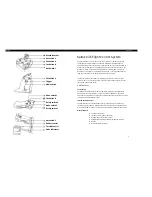
63
In the diagram, a microphone is connected to the mic jack and chassis of the StationPro,
which in turn is routed through a shielded interconnect cable to the mic jack and chassis
of the selected transmitter. Although not shown in the diagram, the transmitter is assumed
to be connected to a 120 VAC or 240 VAC line, and the StationPro is also connected, via
the shields of its interconnect cables, to all the other station transmitters and linear
amplifiers (each of which is also connected to the AC line, sometimes to multiple AC
circuits). The inevitable ground current loops resulting from all these interconnected
radios and amplifiers lead to a small (typically a few millivolts) AC voltage difference
between the StationPro chassis and the chassis of the selected transmitter. In essence, the
small AC current flowing on the interconnecting cable shield is a low-impedance hum
voltage source. From the diagram we see that this hum voltage is
in series
with the
microphone audio voltage, and while it may be only a few millivolts, that is still enough
to be heard on a transmitted signal. Note that this hum voltage is not induced “pickup”,
e.g., from fluorescent light fixtures, or any indication of inadequate shielding. It rather is
caused by AC currents that flow on the
outer
surface of the interconnecting cable shields.
The diagram below shows why modern microphones with dedicated “mic+” and
“mic-“ connections do not have this problem. In the diagram, there is still an AC voltage
caused by ground current loops, but this voltage is no longer in series with the
microphone audio and therefore causes no hum on the transmitted signal. The bottom line
is that StationPro owners who want to use vintage microphones with simple shielded
cables (and no separate “mic-“ wire) must take careful steps to minimize audio hum in
their AM or SSB transmissions.
How to Diagnose Ground Loop Problems
The easiest way to diagnose a potential ground loop problem with your StationPro
is to jumper the microphone audio pin (mic+) to the ground pin or shield on one of the
StationPro’s mic connectors. Then key up your transmitter or transceiver and listen to
your transmitted signal on a separate receiver. If you hear hum on your signal, even with
the mic audio shorted to ground, then you have a ground loop. There is no need to worry
about this ground loop if you are using a modern microphone with a separate “mic-“
wire, but if you wish to use a vintage microphone having a simple shielded cable, then
you will definitely have to deal with it.
Basic Steps to Minimize Ground Loop Hum
1. Make sure all of your station transceivers or transmitter/receiver pairs are connected to
the same AC circuit and not to separate circuits. (Of course, this will not be possible
when using 120 VAC transceivers and 240 VAC amplifiers.)















































